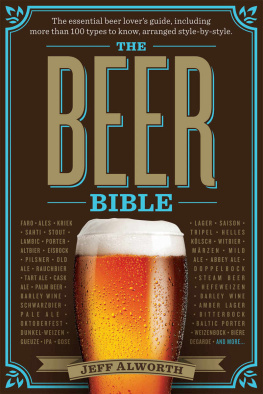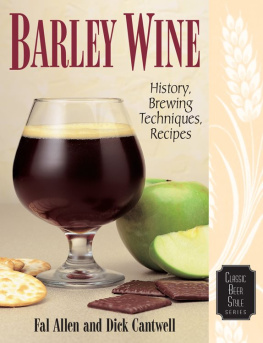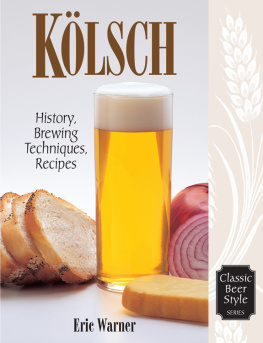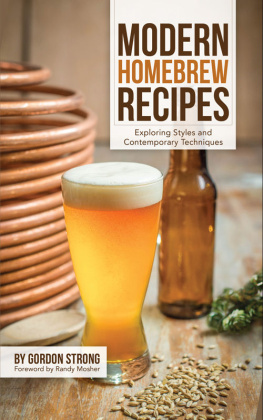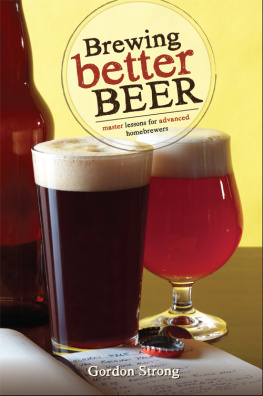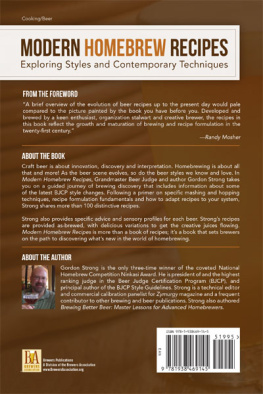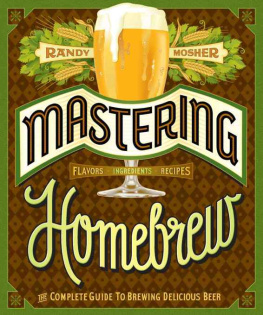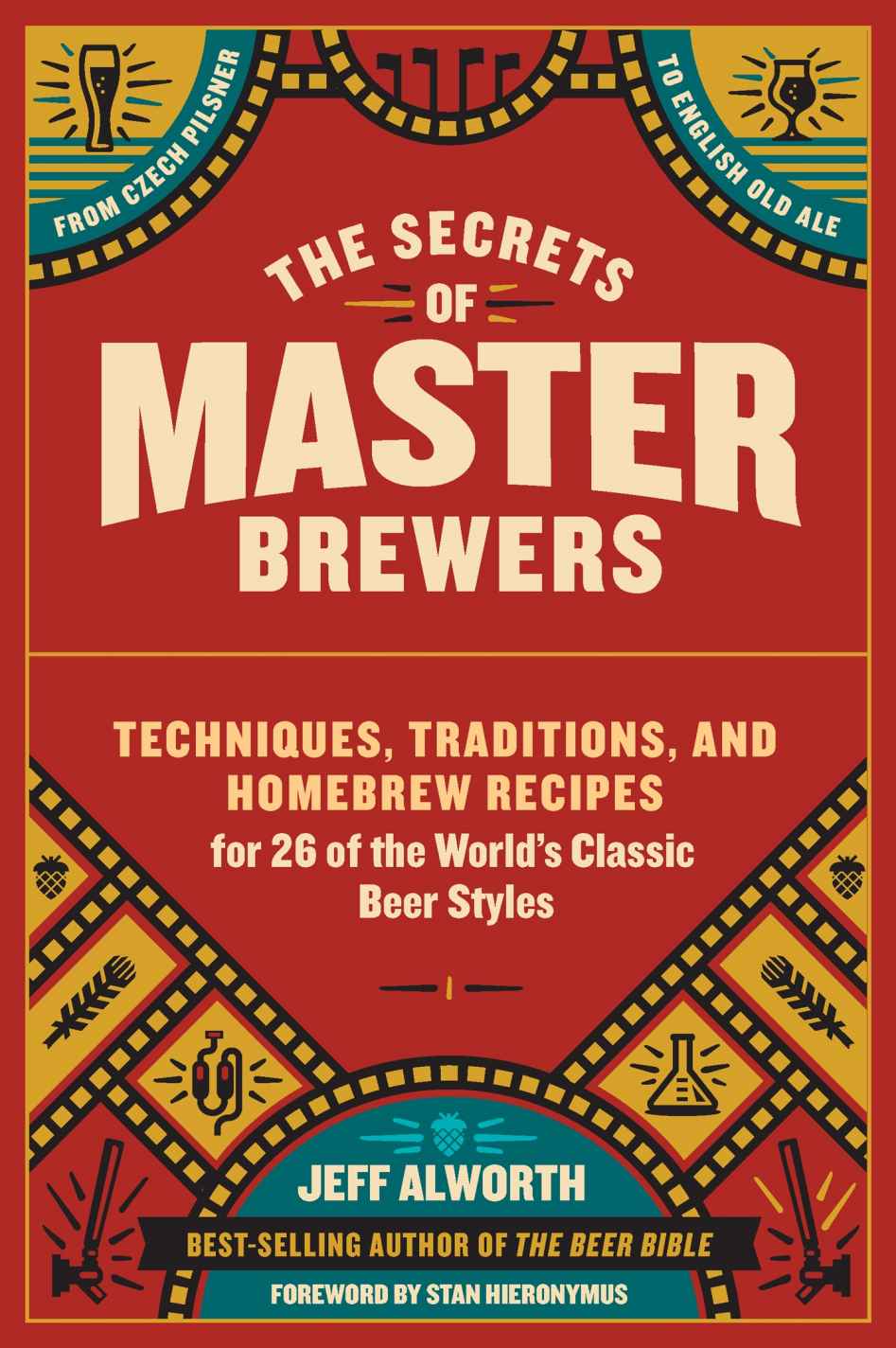Note: Foreign language characters appear throughout the book. Due to font limitations, user ability to change display fonts, and device settings, they may not display correctly. We apologize for any inconvenience.
Contents
Foreword
Ted Rice, at the time a pub brewer at Blue Corn Caf & Brewery in Albuquerque, had never tasted a German-made klsch before he brewed one in 2003 that won gold at the Great American Beer Festival. A few years later, after he had visited Kln, he shook his head when I asked him to compare their beer with the one hed made himself. I can see some similarities, he said, smiling broadly.
Drinking klsch in Kln or helles in the south of Germany put those traditional beers in perspective. You see how delicate and refined they are. What happens when a number of breweries around a town or region all focus on one style is they elevate it, Rice told me. Even a simple... , he paused to consider his choice of words, everyday beer gets better.
In these pages, Jeff Alworth explains how these styles are a result of regional and national ways of thinking about beer. His premise is basic: To really understand the beers brewed in other countries, you have to put yourself in the mind of those brewers, to see how they came to their own basic assumptions and how they shape their beer. He also provides a definition of national tradition, writing, It is a cultural institution, invisible, yet strangely powerful. Like other cultural institutions, it is created and perpetuated by interaction and familiarity.
When Jeff shares the secrets hes learned, he is not referring only to a list of ingredients or even brewing instructions. Brewers have learned directly from each other for millennia. Thats still the way people learn to brew craft beer, according to John Isenhour, a former pub brewer himself and now an instructor at Kennesaw State University whose classes focus on both the scientific and cultural aspects of brewing. His doctoral thesis dealt with the social history of brewing. Before the Industrial Revolution and widespread use of scientific tools such as the thermometer, some knowledge could only be passed directly from brewer to brewer. You had to experience it with him, Isenhour said. Hed say you do this when a mash bites smartly on your finger. You had to be there the first time to know what that meant.
Today, head brewer Jason Thompson can start the first brew of the day at Urban Chestnut Brewing Company in St. Louis from a tablet at home. The sparkling stainless steel 60-barrel brewhouse looms behind a 75-foot-long bar in the brewerys massive beer hall, with all its automation on display. Standing on the brew deck as a batch nears completion in one kettle while another starts to his left, he says, Weve got some action now. This is when it starts to get fun. He doesnt really need to be monitoring the system; hes programmed what ingredients will be added and when, and tweaked the process based on the raw materials.
Those are the essentials Thompson learned during more than a dozen years of brewer-to-brewer education. He began brewing in the Gordon Biersch Restaurant and Brewery chain in 2004. Cofounder Dan Gordon was the first American in more than 40 years to graduate from the five-year brewing program at the Technical University of Munich in Weihenstephan, Germany. There was never a decision [to focus on German-inspired beers], Thompson says. I was going to brew beer and I was hired by a lager brewery.
He went to work for German-born and -trained Florian Kuplent (see ) not long after Urban Chestnut opened in 2011. Its hard to put into words, Thompson says, describing what he has learned from Kuplent. I think we put a lot of emphasis on sourcing good ingredients. Florian comes from a place, our beer here comes from a place, where ingredients are important.
Its easy to visualize the invisible hand Jeff writes about when Thompson talks about adjusting the process to accommodate the raw materials. We can do that because their understanding of what the beer should be is so sound, says Kurt Driesner, Urban Chestnuts quality assurance manager.
Ted Rices 2003 medal illustrates that good ingredients and brewing practices can produce awards, but, as he discovered, the beer itself may not represent the place it comes from. Rice later helped found Marble Brewery, which in 2014 won Small Brewery of the Year at the GABF. Many of his beers have captured medals, including Marble Pilsner, the Kellerbier gold medalist at WBC in 2014 and bronze medalist in 2016. All the other Kellerbier winners were from European breweries.
Are we trying to make a German pilsner? Rice asks. No. We are making an American beer. I never want to make a knockoff. And he comes back to the everyday beers he discovered in Germany. We [American brewers] try to make a broad range for everybody. Thats what we excel at. The things we make every day we do better, he says.
To that end, Jeff Alworth offers us a book full of out-of-the-ordinary everyday beers. Beers that brewers make every day, day after day. Beers that consumers drink every day, day after day.
Pick a style, any style, and begin learning from the best in the business.
Stan Hieronymus
Author of Brewing Local: American-Grown Beer and others
Preface: Revealing the Invisible Hand
If youve ever had a chance to speak to a professional brewer about his approach, I bet you noticed something: he wasnt uncertain. Over the course of two decades, Ive interviewed hundreds of brewers and Im always taken by their level of conviction even when a brewer says something that directly contradicts what I heard from another brewer a week before. In the process of making a beer, a brewer has to consider innumerable issues, like how soft the brewing water should be; what temperature(s) the grain should be mashed at and for how long; and whether filtration should be used and, if so, which type. A brewery is no place for the indecisive.
But how do they arrive at those decisions in the first place? A few years ago, I had the great good fortune to be selected by Workman Publishing to write The Beer Bible . In order to credibly write about the worlds great beer styles, I had to visit breweries and talk to the people who made them. I drew up a list of the dream team of world brewing and asked if I could come and take a tour. Over 50 said yes, and just 2 didnt get back to me in time for the trip. None said no. So off I toddled to places like Fullers and Samuel Smiths, Dupont and Rodenbach, Schlenkerla and Schneider, Budvar and Urquell. It was every bit the fantasy Id hoped for it actually exceeded my hopes but what I took away from the collective experience was an unexpected revelation.
Lets go back to those brewery decision points. Before my world tour, I assumed they would have all been individual, that each brewery would have come to their system through an in-house process of trial and error. Instead, I found something more interesting. It turns out theres a national (or sometimes regional) way of thinking about beer. In some cases its a profound influence, like brewing to Reinheitsgebot in Germany or bottle-conditioning in warm rooms in Belgium. But sometimes it was small and picayune, like how the English would never consider using the sugar made from beets, or how the Czechs use first-wort hopping.



